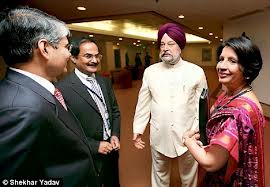During a military regime the chief martial law administrator (CMLA) as can be excepted exercise the crucial role in foreign policy decision making in Bangladesh. Personality also plays important role here. Under the democratic government the role of the foreign minister is also prominent. But this is not the case when the country is ruled by the military. In such a situation foreign minister usually plays a role no better than the personal of the (CMLA). Both civilian and military plays a major role in the foreign policy decision making of Bangladesh. As foreign policy is the extension of the domestic policy many other related ministries, viz. finance planning foreign trade establishment etc. together with defense establishment play important role in making foreign policy decisions. Of late few research institutes like that Bangladesh institute of international and strategies studies have been set up in Bangladesh which contribute to the decision making process by under taking studies on particular problem and issue.
MAJOR TRENDS IN EXTERNAL RELATION
|
Bangladesh since her emergence as an independent sovereign state has witnessed many ups and downs. The path to the development of a truly democratic society was thorny. The democratic goal was some times stymied but could never be stifled .Bangladesh has demonstrated amazing talent in coping with epochal changes and challenges .some of the milestones reflecting the vision and political acumen of the leaders in carrying forward the infant state during the period of transition are:
Joining the NAM in 1919.
Securing the withdrawal of the Indian troops.
Participation in the OIC summit in Lahore in 1974.
Membership of the UN in 1974.
Signing the 5-years Agreement with India in 1977 for sharing the Ganges water.
Election to the UN security council in 1978.
Participation in 22-member North-south submits held in CANCUN (Mexico).
Initiate negotiation on the ownership of S. Talpatty Island 1978.
Agreement with Pakistan on repatriation of pak refugees .
Successful repatriation of Burmese refugees.
Successful initiative in the establishment of the SAARC.
Signing the 30-year agreement for sharing the Ganges water (1997).
The security interest of Bangladesh warrants the acceleration of the pace of consolidation of the hard-won independence. Hence the highest priority must be assigned the national goals of development with the focus on human resources development poverty alleviation and employment generation .the direction of securing the political and economic cooperation of the international community towards achieving these central development goals as speedily as possible. The central goals of human resource development and poverty alleviation should continue to receive the top most priority .Internationally known successful experiments like the Grameen Bank could receive special attention in country projection.
In designing Bangladesh’s foreign policy special attention must be paid to the potential role of Bangladesh as an actor on the international scene. This role can be vastly enhanced in significance if Bangladesh as the eighth largest nation can stay in the mainstream of the nations committed to the UN charter, the principles of NAM, OIC and Group of 77.
India
|
Geopolitically, Bangladesh belongs to South Asia. This is also the most demanding region for BFP. As the largest and strongest nation in South Asia, India tops the list of Bangladesh’s foreign policy concern. The Special and idyllic relationship in which Bangladesh and India found themselves following the liberation war soon started hitting rocks and shoats; and subsequently a list of bilateral issues emerged as a divider between the two countries. The relationship, however, began with dramatic foreign policy success of Bangladesh via-a-via India.
The first government of Bangladesh was credited with arriving at an array of bilateral arrangements consummated in treaties/ agreements and the list includes-
- 1. Treaty of friendship, cooperation and peace
- 2. India-Bangladesh Trade Agreement
- 3. New Trade Agreement
- 4. Land Boundary Agreement
- 5. Indo-Bangladesh Agreement on the peaceful uses of Atomic Energy
- 6. India-Bangladesh air Agreement
- 7. India-Bangladesh cultural Agreement
- 8. India-Bangladesh ad hoc Agreement on Farakka.
As years rolled by the following issues emerged as irritants in the bilateral relations:
- Sharing of Common River waters, particularly that of the ganges.
- Implementation of the 1974 Land Border agreement in general, and accord on the leasing of Tin Bigha corridor to Bangladesh, in particular,
- India’s policy of harbouring the insurgents from the chittagong Hill tracts
- Trade imbalances in fovour of India
- Smuggling, and illegal cross-border activities.
On 18 April 1975, India and Bangladesh reached a one-year ad hoc agreement on Farakka stipulating that Bangladesh would receive at 44000 cusecs of Ganges water during the lean season. Bangladesh needs a permanent and immediate solution.
The background for such a solution was created in mid-1996 when the Awami League Govt. took power in Dhaka and United Front govt. in Delhi. Again, the critical factor of regime compatibility played its role in bringing about a qualitative change in Dhaka-Delhi relations; and through a flurry of diplomatic activities in Dhaka, Delhi and Calcutta a 30-year water treaty was signed on 12 December 1996.The Treaty at least provides a 30-year mechanism to legally bind India to a sharing arrangement.
The long persisting issue of Tin Bigha corrider was resolved in 1992, but in a way different from what had been stipulated in the 1974 agreement. India was supposed to lease the corridor in perpetuity to Bangladesh. But the 1992 agreement stipulated common use by Bangladesh and India.
For over two and a half decades the chittagong Hill Tracts issue has been posing a serious threat to security & economy of Bangladesh. With Cross-border ramifications and with Indian Involvement, the issue at times appeared intractable, but since 1992 with Indian a democratically elected government in power in Bangladesh Indian attitude began changing and the change became more apparent with the AL Government assuming power.
Social and Economic issues
Indo-Bangladesh relations best exemplify the importance of social and economic issues in the relations among nations and the serious effect that disputes in these can have on other aspects of any dyad. In scarcely more than a year after gaining its independence, Bangladesh had developed a sense of dependence on India. Increasingly the Bengalis began to show resentment against what was termed “Indian exploitation.”
A joint command composed of Indian and Bangladesh forces had been set up on December 6, 1971, and though arms were mostly captured by or surrendered to the Indian forces, they were technically in the possession of the joint command. Therefore, Bangladesh had legitimate claims to some of those arms.
The next issue in dispute in Indo-Bangladesh relations in the immediate post-1971 years was the trade pact signed between the two countries. The central feature of this pact was the creation of ten miles of free trade zones on both sides of the border designed ostensibly to promote closer trade relations between Bangladesh and India. Similarly, Consumer goods, medicine tobacco, etc found their way into Bangladesh from India.
The Farakka Barrage
The Farakka Barrage is also designed to “improve communication facilities, drainage, sanitation and water supplies in Calcutta, as well as inland transport throughout west bangle, with a rail and road project over the Farakka. Bangladesh claims that the Ganges is an international river. Therefore, India must Respect Bangladesh’s demand as a lower riparian foe a share in the Ganges water, which is vital for its southwestern districts.
Amount of water to be shared between India and Bangladesh
10-days period | Dependable supplies at Farakka | Amount agreed upon for the Hooghly | Remaining flows for Bangladesh |
| 21-30 April 1975 | 55000 | 11000 | 44000 |
| 1 -10 May 1975 | 56500 | 12000 | 45000 |
| 11-20 May 1975 | 59250 | 15000 | 44250 |
| 21-31 May 1975 | 65500 | 16000 | 49500 |
The Purbasha Island Dispute
The Indian annexation of a newly emerged island known as Purbasha in the Bay of Bengal has not only further soured Indo-Bangladesh Relations but has clearly helped in forming an intense anti-Indian Public opinion in Bangladesh. Bangladesh expressed its complete surprise over this announcement and revealed that Indian had commitments at the highest level to a joint survey which should therefore be honored. New Delhi merely agreed to discuss the question with a view to setting it peacefully but Indo-Bangladesh joint statement issued following this visit failed to mention just how the dispute was to be settled.
However, the Bangladesh government maintains that its navy boats in the area were well within Bangladesh territorial water and in a strongly worded protest note to India, asked for the withdrawal of Indian ships and men from the disputed island. The Bangladesh Government also renewed its call for a joint survey to settle the issue of the island’s ownership.
Much of its India policy is ad hoc response under the circumstances. The failure of the establishment in this regard may be attributed to the divisive political milieu via-a-via India. But it should be categorically stated that neither pro-Indian ebullition nor India bashing rhetoric for political consumption would be helpful. What is needed is a hard headed thinking for a well-thought out and realistic India policy for maximizing our gains.
JAPAN
|
*japans survey found that in Bangladesh investment is cheaper than 21 cities in Asia.
*Investment cost in Bangladesh is cheaper than other country(2004).
*The cities and countries that survey was conducted were seal, Hong Kong, Taipei, Singapore, Bangkok, Kualalumpur, Jakarta, Indonesia, Manila, Mumbai, Bangalore, Karachi, Colombo, Dhaka etc. The comparison was based on 34 cost components. The components included wages for workers, salary for engineers and stuff. Cost for land, office rent, mobile charge, internet charge, electricity, gas, water, fees, cost of petrol, tax, vat etc. Japan external trade organization (JETRO) surveyed it.
The relatively position in Bangladesh is improved in components like rental fee in the industrial estates ,charges for overseas phone call, cost for water and petrol etc.
Bangladesh is loss competitive in the areas monthly basis payment for broad band internet service, new connection fee for fixed telephone line,ISD mobile ,cost of passenger car, container transportation and corporate tax.
New development is added to Bangladesh, that could improved in the investment climate. They are “work permit for foreigners and “visa on arrival”.
For proper transshipment in Chittagong port JETRO suggested to construct a deep sea point in Bangladesh.
Due to the increase in import duty for passenger cars, Bangladesh has become one of the most expensive countries in Asia.
The corporate tax in Bangladesh is 37.5% .That is why they suggested that the evasion should be controlled.
To introduce much more attractive incentives comparing to china, Vietnam and other ASEAN countries JEPRO suggested to the government to concentrate on three aspects – improvement of infrastructure facilities, ensuring speed, security and transparency and continuation in government policies. If the government addresses three aspects gradually, the flow of foreign investment to Bangladesh should increases automatically.
MALAYSIA
|
Like Malaysia ,Bangladesh a predominantly muslim country ,with around 87% of its population being muslim ,it earned international recognition for its moderate religious and cultural ethos ,social tolerance and ethnic cohesion .It characterizes Bangladesh as a liberal and tolerant muslim country .Being the co-member of OIC,NAM commonwealth, D-8 and ARF Malaysia and Bangladesh share common perception to promote peace ,stability and development about 200000 people who are working in Bangladesh .
Bangladesh and Malaysia enjoy good bilateral relations based on the foundation of common religion history and culture. The state of good relation is reflected in the fast growing bilateral co-operation including economic and technical assistant trade and investment employment of Bangladesh workforce in Malaysia .
Today Malaysia is the largest investment partner of Bangladesh and they investment about (RM 4.1 billion) U.S.$ 1.3 billion in 59 projects, mainly in telecommunication ,power, textile, and financial sector.
Bangladesh is the only nation among the worlds 49 least development countries to be self sufficient in the production of pharmaceutical -largely branded generic drugs. In adding with that Malaysia’s leading educational institution, healthier provider and pharmaceutical company visited Dhaka to explore the new market with nearly 140 million people.
FUTURE: Trade co-operation are increasing year by year between Malaysia and Bangladesh by increasing pharmaceutical export. Business groups are calling for free trade argument (FTA) because Bangladesh’s total exports to Malaysia -its largest investment partner among ASIAN were worth just U.S.$ 16.9 million where its import from this totaled U.S.$ 384.11 million.
Malaysia said will continue to contribute positive efforts to promote and expand bilateral relation with Bangladesh particularly in trade and investments.
Malaysia will invest in the potential sector in Bangladesh .They may assured all the technical and logistic support for the upcoming Bangladeshi single country trade fair be held.
Bangladesh got “zero tarrif” to enter Bangladesh product in Malaysia preferring Bangladeshi garments, home textile, handicrafts, halal food,spices ,melamine and medicine.
The Bangladesh Malaysia ties are stated to be an over steady increases with more and more argument being reached ,deeping and widening the area co-operation the relationship between these friendly muslim nation would grew stranger .
BURMA
|
The most recent outflow from Arakan to Bangladesh took place in 1991and 1992. More the 250000 Rohingga refugee fled .With the assistance of UNHCR and non governmental relief agencies ,the Bangladeshi government sheltered the refugees in 19 camps in the vicinity of cox’s Bazar in southern Bangladesh .
South Korea
|
Relations are considered to be productive and progressive. Their relations have gone on to expand in several areas such as defence and trade & investment. Bangladesh also sends a large number of skilled migrant workers to South Korea to work in the following sectors:- construction, manufacture, services, and agriculture, fisheries and livestock.
North Korea
|
There is a North Korean embassy located in Dhaka although Bangladesh maintains a non-residential status. Instead communication with the Juche state and Bangladesh is with the latter’s embassy in Beijing. Relations have only gone as far as recognition and neither nation has ever shown the desire to progress this even further.
South Africa |
Relations began during the inauguration of Nelson Mandela in 1994, and full diplomatic relations were implemented on 10 September, 1994.
Due to the brutality and the White Supremacist ideology of the Apartheid regime, relations between South Africa and Bangladesh were non-existent until the collapse of white minority rule and Nelson Mandela’s rise to power. There is a number of Bangladeshis which make up the South Asian community in South Africa and immigration still continues, although it has temporarily halted due to attacks against foreign workers.
Kuwait Kuwait
|
Bangladesh exports its raw materials such as leather, finished jute and also garments and textiles. South Africa exports to Bangladesh are iron ore, steel, aluminum, infrastructure projects and machinery and equipment for railways.
Relations between the two countries are considered strong based on common religion and values. A turning point in relations occurred during the Gulf War when Bangladesh sent a contingent of 2,300 personnel to monitor peace in Saudi Arabia and Kuwait and a contributor to UNIKOM with a mechanised infantry battalion. Bangladesh sends guests workers to Kuwait to enable its citizens to work in higher paying jobs leading to remittances as well as there being a Bangladeshi community present in the country. Relations between the two countries have even indulged into military ties since the 1980s and a deal signed in February 1, 2004 under which Bangladesh Armed Forces are to provide technical and vocational training to the Kuwaiti army for the next six years.
Germany |
Both Germany and Bangladesh share common views on various international issues and work together in the UN and in other international forum.
After the independence of Bangladesh in 1971, Germany was one of the first European countries to officially recognize Bangladesh in 1972. Bangladesh also warmly greeted German reunification. As an economic power as well as an important member of the European Union (EU), Germany is a reliable partner of Bangladesh in development cooperation. Since independence German churches and numerous NGOs made tremendous efforts to promote the social and economic development of Bangladesh. German assistance to Bangladesh is received in the form of development efforts, trade and cultural cooperation. Both countries have a long and successful bilateral relationship on most international issues. Germany always emphasizes the democratic characteristics, governance issues and development process of Bangladesh. Germany developed as a democratic country in deep remorse for World War II and became one of the top most economic powers of the world. After establishment of diplomatic relations, the bilateral relations between the two countries began to grow steadily.
Between the start of development cooperation in 1972 and the end of 2005, Bangladesh received approximately $2.3 billion in commitments from Germany as part of bilateral Financial and Technical Cooperation in addition of the funds provided by the German churches and NGOs. At an intergovernmental negotiation in 2005, Bangladesh received ? 14 million in new commitments from Germany. Since 1978, all German funds provided as part of government level cooperation have been in the form of non-repayable grants.
Bangladesh is a priority partner country of German Development Cooperation (GTZ). By an agreement between both the government adopted in May 2004, the activities of the GTZ focus on three priority areas such as healthcare including family planning, economic reform and development of the market system through promotion of private sector, especially SMEs, and renewable energies. Among the other ongoing projects the promotion of legal and social empowerment of women in Bangladesh is also to be mentioned. The sustainable economic development program of GTZ in Bangladesh contributes to the competitiveness of the RMGs sector, as well as other export-oriented sectors like silk, leather and jute.
In trade with Germany, Bangladesh has for years recorded a large surplus. Germany is the second largest export market of Bangladesh after the US. Bangladesh exports in Germany in 2006 amounted to ? 1.56 billion as compared with Bangladesh imports in the same period of only ? 305 million. About 94% of the exports from Bangladesh to Germany are RMGs and Bangladesh imports mainly comprising machinery, chemical and electrical goods, and medicines. A German-Bangladeshi investment promotion and protection agreement has been in force since 1986 and a bilateral double taxation accord since 1993. So far German direct investments in Bangladesh are almost ? 60 million. The Bangladesh-German Chamber of Commerce and Industry (BGCCI) acts as a business platform and mediator between both the countries and promotes bilateral trade relations by coordinating and providing required information and services.
The cultural relationship of both the countries is very strong. The cultural cooperation between them is mainly channeled through the Goethe Institute that work on developing the cultural ties between both the countries by sponsoring local and German cultural activities. Bangladesh has traditional and historical connection with Germany. There is a century-old exchange between German and Bengali people. German interest in the culture of Bengal dates back to the visits to Germany by the Bengali national poet and Nobel laureate for literature Rabindranath Tagore in the 1920s and 1930s. Many Bangladeshi intellectuals take a keen and informed interest in German literature, art, architecture and philosophy. In Bangladesh Goethe Institute is the main meeting place for all those interested in Germany.
Goethe-Institute Dhaka with headquarters in Munich offers a broad variety of cultural events to present the German culture in Bangladesh through its main activities by film-workshops, film-presentations, seminars and lectures on socio-political subjects as well as on aspects on contemporary arts, theatre performances, and exhibitions of German and Bangladeshi artists.
Environmental care and consequences of globalization are covered in the workshops and seminars. The Institute offers an extensive language course program up to intermediate level where about 600 students learn German in every year. There are around 350 academics received training in Germany with German funding; some of them now hold important positions in the administrative and academic institutions of Bangladesh. A foreign professional chair is sponsored by the Bangladeshi government at the University of Heidelberg’s South Asia Institute.
Bangladesh has traditional and historical connection with Germany, and both the countries enjoy closest ties. There are increasing contracts amongst German and Bangladeshi artists, primarily in the fine arts, photography/film and theatre. Bangladeshi artists have been able to exhibit in German galleries and museums. A number of visual artists from Bangladesh have also made Germany their new home. Germany continues to promote the restoration of historical monuments, archeological research and the unique legacy of the Bengali catamarans. Since 1981, a cooperation agreement has been in place between Radio Bangladesh and Deutsche Welle (DW).
The bilateral commercial and trade interests of both the countries are continuing, although there is considerable scope for greater engagement. Bilateral relations got some momentum by several high level visits, contracts, and political and economic dialogue. In December 2000, the then head of the government of Bangladesh officially visited Germany. In February 2004, a German nine-member parliamentary delegation also visited Bangladesh. Both Germany and Bangladesh share common views on various international issues and work together in the UN and in other international forum. They have maintained and developed close and friendly relations in a wide range of field. The two countries are harmonized together by their commitment to various sectors mutually agreed upon, which is expected to be strengthened further in future.
USSR
|
Bangladesh relies on substantial foreign aid: more than US$1 billion a year. The Netherlands share in ODA is approximately 3.5% (€33.8 million in 2003). The Netherlands plays a central role in the priority sectors education, health care and water. The added value it provides is mainly to be found in expertise and experience as well as attention for gender and donor coordination. Dutch non-governmental organizations are well represented in Bangladesh.
The former Soviet Union supported Indians actions during the 1971 Indo-Pakistan war and among the first to recognize Bangladesh. The USSR initially contributed considerable relief and rehabilitation aid to the new nation. However, Soviet-Bangladesh relation cooled.
In 1989, the USSR ranked 14th donor of Bangladesh. The Soviet focuses on the development of electronically power, natural gas and oil and maintained active cultural relations with Bangladesh. They financed the Ghorasal thermal power station the largest in Bangladesh. Recently Russia has conducted an aggressive military sales effort in Dhaka and has succeeded with a 124-million dollar deal for eight MIG- 29 fighters.
China
|
China has been the number one important source for Bangladesh. Bangladesh Bank’s figures showed the country imported Chinese goods worth $2292.12 million during July-March of the current fiscal year that ends this month-end. The amount was 15% of the country’s total import during the period. In 2006-2007 fiscal year, $2537 million-worth imports from china during the same period while in 2005-2006 from stood at $2050.99 million.
In, April 09, 2005, Bangladesh and China have signed nine agreements reflecting their increased bilateral relations during two-day visit by the Chinese prime minister Wen Jiabao to Bangladesh. The two prime ministers’ had expressed a determination to strengthen bilateral relations and efforts for regional peace. The nine deals signed included co operation in peaceful use of nuclear energy. Absolutely for peaceful use of nuclear energy for use in the field of nuclear medicine, power generation, agriculture & bio technology.
The countries signed an agreement for agencies in capacity building of the law enforcing agencies in Bangladesh. Under the economic and technical co-operation agreement, China will provide $6 million for capacity building of civil servant, china will convert the full supplies credits for a DAP plant in Chittagong to concessional loan.
The two countries also signed a memorandum of understanding on installation of digital telephone exchanges in metropolitan cities, important distinct headquarters and upazilla growth centers in Bangladesh at cost of $400 million.
The deal will initiate a direct air link between Dhaka and Beijing from May 18, china will also consider Bangladesh’s proposal for duty free access of its products to china’s market. China and Bangladesh also declared the year 2005 as “Bangladesh- China Friendship Year”.
Bangladesh and China are partners in the new Asian age and the visit of foreign minister Yang Jiechi will further cement his relationship.
China has shown keen interest in even a bigger role in the development of Bangladesh. They want to involve in larger projects, Roopur Nuclear Power plant for instance. Bangladesh-China peaceful nuclear power corporation can be built on the china Pakistan model.
Chinese support is crucial for implementing the tri-nation road network to forge deep strategic relation between South East Asia. A similar road network encompassing North Eastern portal India, Bangladesh and China will be beneficial.
Bangladesh should rather ask for big ticket Chinese investment in industrial sector. We import capital machinery, industrial raw materials and telecommunication equipments from china. Bangladesh can offer cheaper labor and utilities. This way we get the technology and our worker get jobs.
USA
|
The basic American foreign policy goals in Bangladesh are:
Maintenance of effective relations with the Bangladesh government and encouragement of an atmosphere favorable to the U.S. mission.
Support for the normal ration of relation in the subcontinent.
Assistance to develop a stable political and economic system.
Assistance to meet short term humanitarian needs and to encourage economic development.
The US has long standing supportive relation with Bangladesh and has viewed Bangladesh as a moderate voice in the Islamic world. They interested in Bangladesh include political stability and democratization social and economic development, environmental issue and improvement of human rights situation.
Americans moved speedily in committing the aid. The Nixon administration committed $130 million. The remainder of $200 million authorized by US congress. According to figures complied by the United Nation Relief Operation Dhaka (UNROD) on amount of foreign assistance to Bangladesh upto 17, 1972.
In 30 june 1973 the US provided Bangladesh $433 million. In 1979 Bangladesh had sought US help in setting up a research re actor in savar near Dhaka.
Recent development
– In 2007 elections, the current political situation came after emergency rule was declared by President Iajuddin Ahmed about protest and strikes.
– In 2001, The US military did deliver four military aircraft to Bangladesh.
– In 2003, Bangladesh was a added to the list of countries whose nationals visiting the United States must register with immigration authorities for security purpose.
Import and export
The United States export wheel, fertilizer, cotton, communication equipment and medical supplies among other goods to Bangladesh. Readymade garments and jute carpet backing are two of Bangladesh‘s key export to the US. The US has generally had a negative balance of trade with Bangladesh since 1986.
Pakistan
|
Bangladesh and Pakistan – two major nations of South Asia share a common historical, religious and cultural heritage.
The normalization of any sort of relationship between Bangladesh and Pakistan was not possible until the later formally recognized the independence of the former. Islamabad placed three criteria determining the eligibility for repatriation:
A) Central- government employees.
B) Divided families.
C) Domiciled citizens.
A major area of conflict between Bangladesh and Pakistan is the issue of repatriation of stranded Pakistanis in Bangladesh. It is important to note that about 10 lakhs non-Bangalis had been stranded in Bangladesh after independence. Of then 5 lakhs opted for residing in Bangladesh and he rest claimed their repatriation to Pakistan. They enlisted their names in the list prepared by International Red Cross Society during 1972-73.
In August 27, 1977 Foreign Secretary of Bangladesh visited Pakistan and it was agreed upon the issue that Pakistan would certainly take 25,000 non-Bangalis from Bangladesh when president Ziaur Rahman Visited Pakistan in 1977 the Government in Islamabad agreed to speed up the process of repatriation. Again on July 20, 1978 Foreign Secretary of Bangladesh, during his visit to Pakistan, requested the government of Pakistan to complete the process of Repatriation of non-Bangalis from Bangladesh.
October 25, 1980 Pakistani Foreign Secretary Reaz Piracha visited Bangladesh but avoided the discussion of the question by saying “since we have no dispute there is no question of agreement to be reached in this meeting”. Finally, when Pakistani foreign minister Lt. General Shahibjada Yakub Khan visited Bangladesh on August 10, 1983 the issue was brought before him. In an Interview with the journalists in Dhaka, Pakistani foreign minister expressed that Pakistan might take 50,000 more non-bangalis from Bangladesh but reiterated the criteria as proposed by Pakistan in the tripartite conference in 1974.
An immediate manifestation of the establishment of diplomatic relations was the restoration of telecommunication links through satellites between Bangladesh and Pakistan. In July 1976 air communication was also restored between these two countries. In October of the same year Shipping Communication started. Pakistan International Airlines (PIA) offered a Boeing to Bangladesh in November. In addition, Pakistan offered 28 railway coaches to Bangladesh. Bangladesh presented tea during flood in Pakistan which in turn, presented to Bangladesh rice and clothes during its flood situation.
Another important element which has contributed in promoting cooperation is the introduction of the visa system between Bangladesh and Pakistan.
On August 10, 1983 Pakistani Foreign minister Lt. General Shahibjada Yakub Khan came to Bangladesh. In a joint communiqué it was stated that different types of visa including tourist visa will be introduced. However, no visa will be required for the transit passengers for 72 hours.
Some efforts were also made in 1979 to establish cultural relations between these countries. They signed a cultural agreement in October 16, 1979. Teachers and scholars of the universities and other educational institutions of Bangladesh and Pakistan as well as scientific and industrial training for their students on mutual basis. They would also exchange radio and T.V. programs and films and promote free flow of books and magazines under their existing laws and regulations.
Apart from the bilateral context Bangladesh and Pakistan have closely cooperated in international forums. Bangladesh and Pakistan are of the opinion that a zone of peace in the Indian Ocean could be established by eliminating the rivalry of the great powers and creating conditions of security for all the countries of the region. Both the countries pledge their adherence to the charter of Islamic conference (OIC).
They have maintaining trade relations since president Zia’s visit to Pakistan in 1977. In economic field the main issue of conflict has been the question of division of assets until 1971 between Bangladesh and Pakistan.
The Muslim world
|
In the last five years Pakistan has become one of the biggest buyers of Bangladesh jute and tea. Bangladesh has also imported huge quantities of cotton and cloth from Pakistan.
Geographically Bangladesh belongs to the region of South and South East Asia and lies as a bridgehead between South and South East Asia. The Bengalees are not culturally as close to the Arabs, Persians or Turks as the Pakistanis or North Indians are. Geo-political reality of Bangladesh does not necessitate her closeness with the Muslim world.
i. The viability of Islam as a political ideology.
- ii. Development of Bangladesh’s relations with the Muslim states in phases.
- iii. Economic aid as an influential factor.
Islam as an issue area of foreign policy:
i. Influence dispute over a territory and friendship or hostility among states.
ii. Despite the cohesiveness produced within a nation or a group of nations, it generally exerts a disturbing influence.
iii. There is a strong opinion in these states to treat Islam as a political ideology even though there are other ideologies.
iv. Islam and Christianity, two competing religion based on state system, after a long period of mutual competition and warfare have reached the inevitable conclusion that neither can impose its legal and political system on the other.
v. Separation between religious doctrines and conduct of foreign relations.
vi. Technological development spread of modern education and influence of European political institutions brought about substantial change in the thinking of the Muslim politicians and intellectuals.
- vii. The Muslims wanted to retain religious in the face of any other ideology but rejected the spiritual aspects of the religious at the same time.
Bangladesh in the Muslim world:
The evolution of Bangladesh’s relations with the Muslim countries may be divided into three phases. The first phase began with the emergence of Bangladesh and ended with the recognition of Bangladesh by Pakistan. The second phase began in February, 1974 and ended in August, 1975. The third phase began in post – August 1975 and it still continues.
No Arab country recognized Bangladesh till the beginning of the second half of 1972, Malaysia and Indonesia, the two Muslim states of the South-East Asian region. Malaysia decided to help Bangladesh purchase a Fokker friendship plane by extending the necessary amount as grant. Bangladesh’s membership in the United Nations. Malaysia on September 23 and Indonesia on October 2, 1972 made powerful please on the UN platform to admit Bangladesh in the United Nations. In the same debate Afghanistan also spoke for admitting Bangladesh in the United Nations. Egypt, Iraq and South Yemen voted in favor of Bangladesh’s membership in the WHO.
















